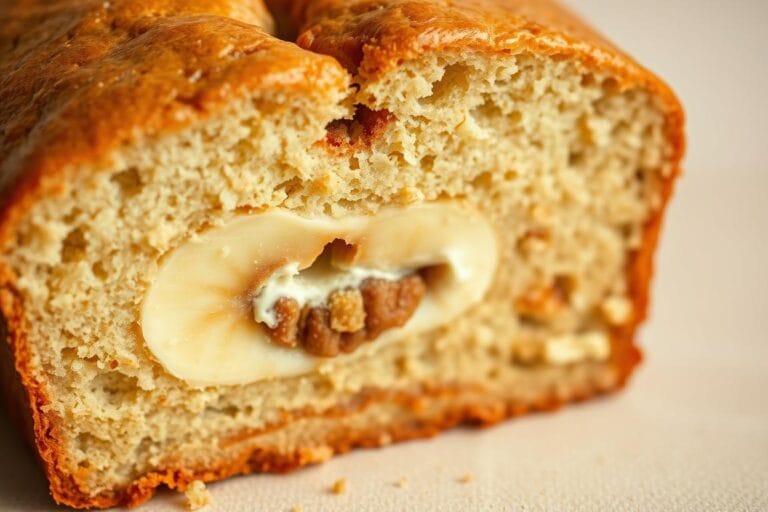Mitarashi Dango: How to Make Japan’s Sweet and Savory Skewered Treat at Home
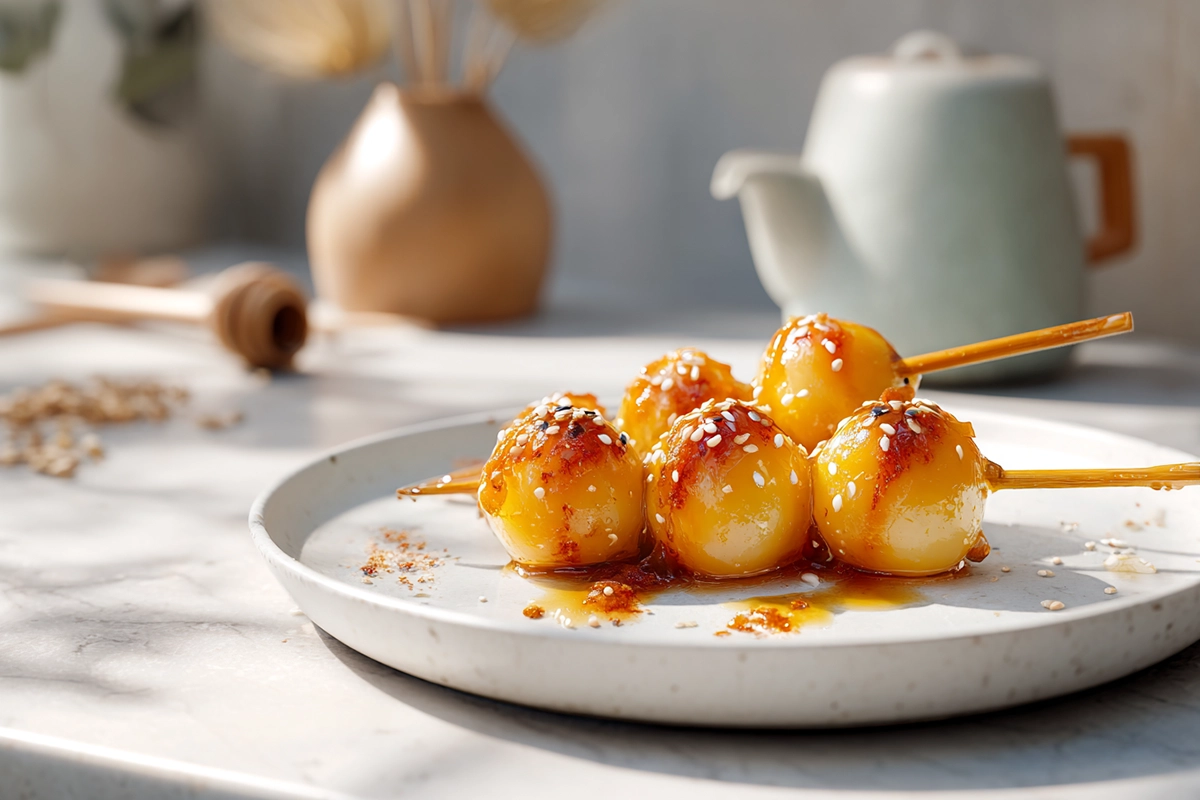
If you’ve ever strolled through a Japanese festival or caught a scene in an anime where someone bites into a glossy, golden-brown skewer, you’ve likely seen Mitarashi Dango. The first time I tried it, I was standing near a small tea house in Kyoto—sweet soy glaze dripping down my fingers, warm rice dumplings melting in my mouth. The blend of smoky char and caramelized sauce was unlike anything I’d ever tasted. And the best part? You can recreate that same nostalgic flavor right in your own kitchen.
This traditional Japanese dessert is made from chewy rice dumplings brushed with a sweet soy glaze and grilled to a golden sheen. Whether you’re looking to try your hand at Japanese street food or simply want to surprise your family with something unique, Mitarashi Dango is both approachable and satisfying.
Origin and Cultural Significance of Mitarashi Dango
Mitarashi Dango traces back to Kyoto’s Shimogamo Shrine, where it was said to be inspired by the bubbles formed in the shrine’s cleansing waters. Each skewer traditionally holds five dumplings—symbolizing the human body—though in other regions, you might find three or four per stick.
You’ll see Mitarashi Dango sold at festivals, temple fairs, and street stalls across Japan. It’s part of the wagashi (traditional sweets) family, often paired with green tea. While mochi and dango share that signature chewiness, dango stands out for its subtle flavor and warm glaze. Over time, it’s made its way from Kyoto’s tea houses to convenience stores and cafés worldwide, finding a spot in the hearts (and kitchens) of dessert lovers everywhere.
Print
Mitarashi Dango
- Total Time: 30 minutes
- Yield: 4 servings 1x
- Diet: Vegan
Description
Mitarashi Dango is a traditional Japanese dessert of chewy rice dumplings skewered and glazed with a glossy, sweet soy sauce. Lightly grilled for a toasty aroma, it balances sweetness and saltiness in every bite. Perfect for tea time or as a comforting treat made right in your kitchen.
Ingredients
For the Dango (Rice Dumplings)
1 cup shiratamako or joshinko (glutinous rice flour)
½ cup warm water (adjust as needed)
For the Glaze (Mitarashi Sauce)
3 tablespoons soy sauce
4 tablespoons sugar
2 tablespoons mirin
1 teaspoon cornstarch mixed with 2 teaspoons water (slurry)
Instructions
-
In a bowl, combine rice flour and warm water until smooth and slightly firm. Adjust with more flour or water as needed.
-
Roll the dough into small balls, about one inch in diameter.
-
Bring a pot of water to a gentle boil and cook the dango until they float to the surface. Continue boiling for one more minute.
-
Transfer to an ice bath to cool, then drain well.
-
Thread 3–5 dumplings onto bamboo skewers.
-
Grill or sear over medium heat until light golden spots form.
-
In a small pan, combine soy sauce, sugar, and mirin. Bring to a simmer, then stir in the cornstarch slurry to thicken the glaze.
-
Brush the glaze over the skewered dango while warm.
-
Serve immediately for the best texture and flavor.
Notes
Use shiratamako for a chewy, elastic texture; mochiko creates a softer bite.
Avoid overcooking — boiling too long makes the dumplings mushy.
Freshly made dango tastes best the same day.
To reheat, steam lightly or microwave with a small sprinkle of water.
- Prep Time: 15 minutes
- Cook Time: 15 minutes
- Category: Dessert
- Method: Boiling and Grilling
- Cuisine: Japanese
Nutrition
- Serving Size: 1 skewer (about 4 dumplings)
- Calories: 12 g
- Sugar: 12 g
- Sodium: 320 mg
- Fat: 0.5 g
- Saturated Fat: 0 g
- Unsaturated Fat: 0.5 g
- Trans Fat: 0 g
- Carbohydrates: 42 g
- Fiber: 1 g
- Protein: 3 g
- Cholesterol: 0 mg
Ingredients and Key Components
The simplicity of Mitarashi Dango is what makes it so appealing. You only need a few pantry staples, though getting the texture just right takes a bit of attention.
For the Dango (Rice Dumplings)
- 1 cup shiratamako or joshinko (glutinous rice flour)
- ½ cup warm water (adjust as needed)
For the Glaze (Mitarashi Sauce)
- 3 tablespoons soy sauce
- 4 tablespoons sugar
- 2 tablespoons mirin (or sweet rice wine)
- 1 teaspoon cornstarch mixed with 2 teaspoons water (for thickening)
If you can’t find shiratamako, you can substitute mochiko, a sweet rice flour available in many Asian markets or online. Just remember: shiratamako gives the dango a smoother, more elastic bite, while mochiko makes it slightly softer.
Step-by-Step Preparation
Mix and Shape the Dough
In a medium bowl, combine the rice flour with warm water until you get a smooth, pliable dough. It should feel firm but slightly bouncy to the touch—similar to modeling clay. If it cracks, add a few more drops of water; if it’s too sticky, sprinkle in a bit more flour.
Roll the dough into small, even balls about one inch in diameter. This size helps them cook evenly and fit nicely on the skewers.
Boil the Dango
Bring a pot of water to a gentle boil. Drop the dango in carefully and let them cook until they float to the surface, which takes about three to four minutes. Once they rise, continue boiling for another minute, then transfer them immediately to an ice bath. Cooling them this way helps set their chewy texture.
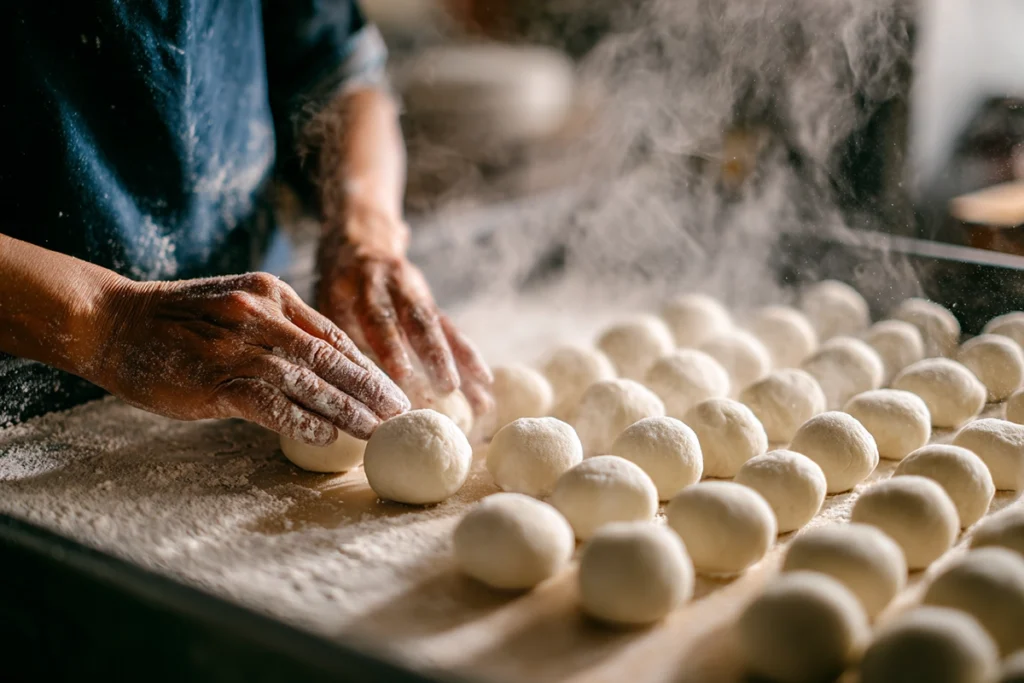
Grill and Glaze
Thread three to five dumplings onto bamboo skewers. Heat a non-stick pan or grill over medium heat and sear each side until light golden spots form. The goal isn’t to burn them but to achieve that smoky aroma and a delicate crust.
In a small saucepan, combine soy sauce, sugar, and mirin. Stir gently as the sugar dissolves. Add the cornstarch slurry to thicken the glaze until it coats the back of a spoon. Brush this glossy sauce over the grilled dango, turning each skewer to coat evenly.
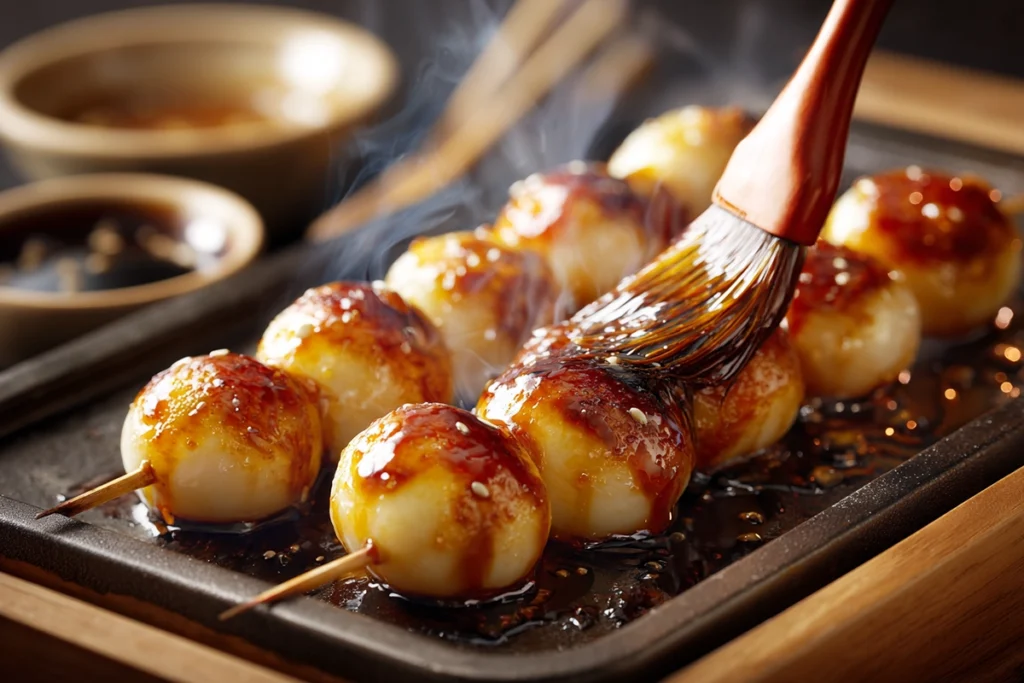
The moment you brush the glaze on, it caramelizes slightly, releasing a toasty fragrance that’ll fill your kitchen. It’s the perfect harmony of sweet and savory in every bite.
Dietary Variations
Vegan Version
Swap out mirin for a mix of rice vinegar and maple syrup or sugar water. Make sure to use a plant-based soy sauce and double-check that it contains no animal-derived ingredients.
Gluten-Free
The rice flours are naturally gluten-free, but soy sauce isn’t always. Opt for tamari, which delivers the same depth of flavor without the gluten.
Low-Calorie
You can cut the sugar in the glaze by half or replace it with coconut sugar for a lighter sweetness. Reducing the mirin slightly will also lower the calorie count without losing balance.
Halal and Kosher
Use alcohol-free mirin (often labeled “mirin-style seasoning”) or substitute with honey and rice vinegar for a similar tang. Be sure your soy sauce brand is certified Halal or Kosher if needed.
These small adjustments keep Mitarashi Dango accessible for nearly any dietary preference while staying true to its signature taste.
Variations and Fusion Twists
Once you’ve mastered the classic version, try branching out. Some regions use fewer dumplings per skewer or even add a layer of anko (red bean paste) for sweetness. You can also roll the cooked dango in sesame seeds or coat them with a thin drizzle of matcha glaze for a modern touch.
If you’re feeling playful, experiment with fusion ideas—think chocolate-dipped dango, fruit-topped versions, or a caramel miso glaze. These updates respect the traditional form while giving your dessert a personal twist.
Storage and Reheating Tips
Like most rice-based sweets, Mitarashi Dango tastes best freshly made. The texture begins to harden after a few hours, so try to enjoy it the same day.
If you do have leftovers, store them in an airtight container at room temperature for up to a day, or refrigerate for two days. To revive the chewiness, lightly steam the dango for a few minutes or sprinkle them with water and microwave for 10–15 seconds. Avoid freezing—they tend to lose their texture once thawed.
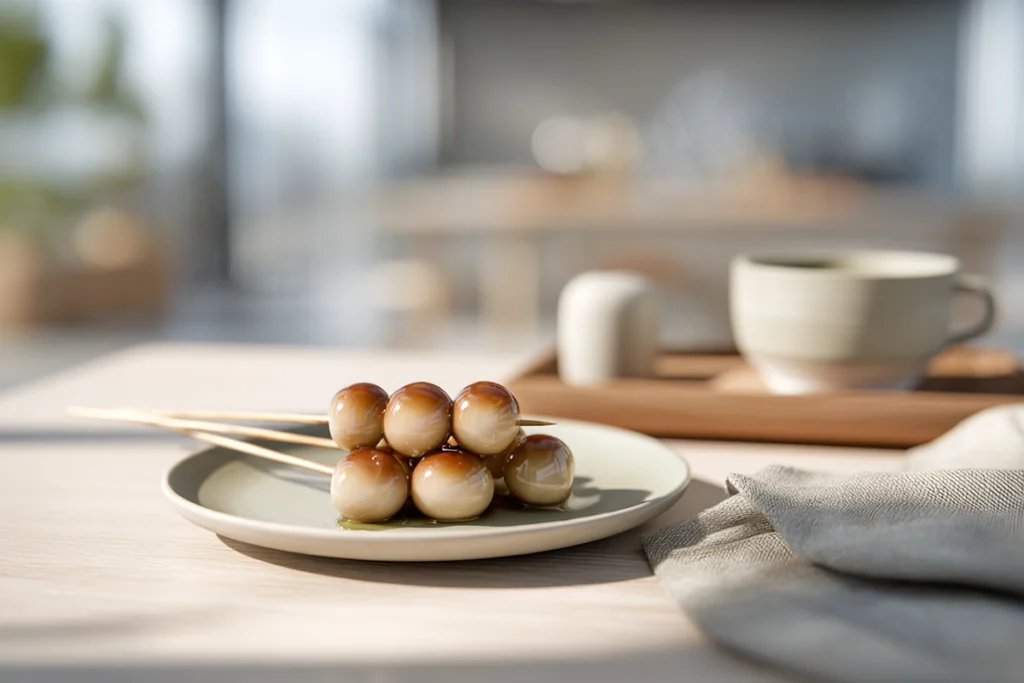
There’s something soothing about making Mitarashi Dango from scratch—the kneading, rolling, and watching those tiny dumplings float to the surface feels meditative. Each skewer carries a taste of Japanese tradition: soft, chewy dumplings with a glossy, soy-sweet glaze that hits all the right notes of comfort and nostalgia. Whether you’re recreating a memory from your travels or just craving something new, this humble treat reminds you that simple ingredients can create extraordinary moments.
FAQ
What is Mitarashi Dango?
Mitarashi Dango are skewered rice dumplings (made from glutinous rice flour) that are grilled and coated in a sweet-savory soy glaze. They are a classic Japanese street snack, prized for their chewy texture and glassy sauce finish.
Why did my dango crack or fall apart while boiling?
If your dough is too dry or under-kneaded, the dumplings may crack or disintegrate. Try adding a little more warm water (a teaspoon at a time) and kneading until smooth. Ensure you boil gently and transfer them promptly once they float.
Can I make Mitarashi Dango gluten-free or vegan?
Yes. Use a gluten-free soy sauce substitute (like tamari) and choose a mirin alternative or alcohol-free version. For vegans, make sure your sugar is plant-based (unrefined or certified) and replace any non-vegan ingredients in the glaze.
How should I reheat leftover Mitarashi Dango?
To revive their chewiness, lightly steam or mist them with water and microwave for 10–15 seconds. You can also rewarm with gentle grilling or pan-searing before reapplying the glaze to freshen the texture.
What Are Our Readers Saying?
There are no reviews yet. Be the first one to write one.





